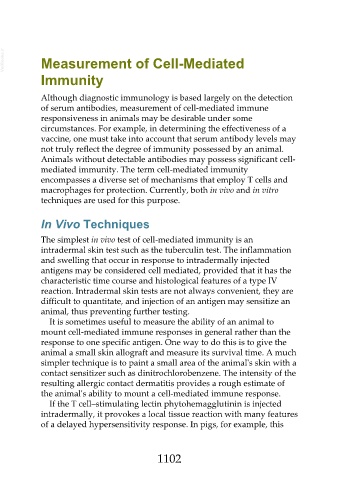Page 1102 - Veterinary Immunology, 10th Edition
P. 1102
VetBooks.ir Measurement of Cell-Mediated
Immunity
Although diagnostic immunology is based largely on the detection
of serum antibodies, measurement of cell-mediated immune
responsiveness in animals may be desirable under some
circumstances. For example, in determining the effectiveness of a
vaccine, one must take into account that serum antibody levels may
not truly reflect the degree of immunity possessed by an animal.
Animals without detectable antibodies may possess significant cell-
mediated immunity. The term cell-mediated immunity
encompasses a diverse set of mechanisms that employ T cells and
macrophages for protection. Currently, both in vivo and in vitro
techniques are used for this purpose.
In Vivo Techniques
The simplest in vivo test of cell-mediated immunity is an
intradermal skin test such as the tuberculin test. The inflammation
and swelling that occur in response to intradermally injected
antigens may be considered cell mediated, provided that it has the
characteristic time course and histological features of a type IV
reaction. Intradermal skin tests are not always convenient, they are
difficult to quantitate, and injection of an antigen may sensitize an
animal, thus preventing further testing.
It is sometimes useful to measure the ability of an animal to
mount cell-mediated immune responses in general rather than the
response to one specific antigen. One way to do this is to give the
animal a small skin allograft and measure its survival time. A much
simpler technique is to paint a small area of the animal's skin with a
contact sensitizer such as dinitrochlorobenzene. The intensity of the
resulting allergic contact dermatitis provides a rough estimate of
the animal's ability to mount a cell-mediated immune response.
If the T cell–stimulating lectin phytohemagglutinin is injected
intradermally, it provokes a local tissue reaction with many features
of a delayed hypersensitivity response. In pigs, for example, this
1102

